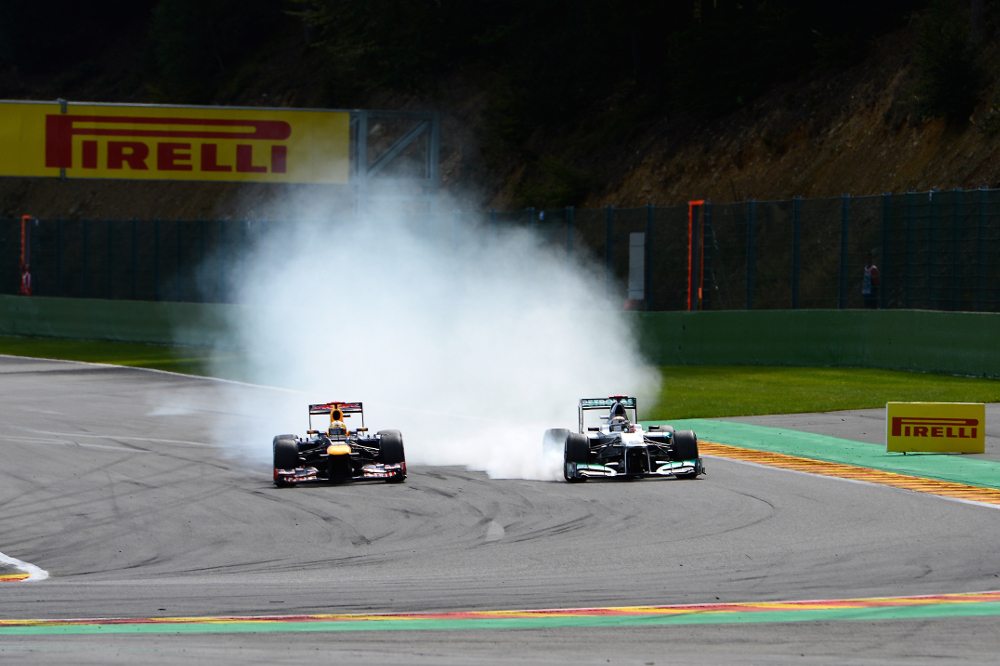Pirelli previews F1 return from mid-season break at Spa
 Sebastian Vettel and Michael Schumacher demonstrate the strain placed on F1 tyres at Spa in 2012
Sebastian Vettel and Michael Schumacher demonstrate the strain placed on F1 tyres at Spa in 2012
Following a three-week break the 2014 Formula One season will resume at the fan-favourite Spa-Francorchamps circuit. Pirelli will supply its P Zero White medium and P Zero Yellow soft tyres, a softer choice compared to last year – the exclusive tyre supplier says this allocation is designed to promote different strategies on what is, at 7km, the longest lap of the year.
Mixing fast straights, flat-out corners, abrasive asphalt and swooping elevations puts great strain on the tyres, while variable weather is a common feature of the Ardennes Mountains circuit. Often it can be raining on one part of the circuit but completely dry at another part, meaning that the versatility of cars, tyres and drivers is tested to the limit as well.
Paul Hembery, Pirelli motorsport director states: “Spa is one of the most epic circuits of the year, and a track we know well from our experience of GT racing at the Spa 24 Hours too. An adaptable tyre is the key element, able to work equally well within the very wide range of track and weather conditions that we often see in Belgium.
“Despite the fact that tyre wear and degradation is traditionally high at Spa – the result of the multiple energy loadings put through the tyres – we have been able to nominate the soft tyres here as well as the medium for the first time since 2011, with the softer option liable to be the preferred choice in qualifying due to a significant time gap.
“This is because of the length of the lap, meaning also that strategy is a very big factor in Spa: there is more time to be won and lost by being on the right tyre at the right time than at many other venues. It’s the sort of race where, under the right circumstances, it’s absolutely possible to go from last to first – and that always makes for a very exciting grand prix.”
Jean Alesi, Pirelli consultant, adds: “Spa is simply the best when it comes to driving pleasure but it’s also very difficult – both in wet and dry conditions. From a tyre point of view, it’s really demanding. The asphalt is very abrasive, so tyre wear is always high.
“When I first started driving we had qualifying tyres and it was actually hard to get to the end of a single flying lap on those without experiencing some sort of blistering. By the time you got to the bus stop chicane, just before the pits, the tyres were already very worn.
“Now it’s different as the tyres are a lot more resistant. You need quite low downforce for Spa, otherwise you won’t have the speed on the straights, and that’s really where you get the time. The abrasiveness of the circuit actually becomes an advantage when it’s wet, which is quite a frequent occurrence. Even when it’s raining, there’s still quite a lot of grip.”
Pirelli says the key to Spa is managing the colossal amount of energy going through the tyres, from every direction. At Eau Rouge, for example, the engines are at maximum power, the cars are travelling at 300km/h, and there is a negative compression in the region of 1g, as well as about 5g of lateral force. This adds up to an unparalleled demand on the tyre structure and shoulder, not seen anywhere else during the year
The medium tyre is a low working range compound, capable of achieving optimal performance even at a wide range of low temperatures – which is often the case at Spa. The soft tyre by contrast is a high working range compound, suitable for higher temperatures. Rain is common at Spa, but there was no rain at the Spa 24 Hours last month or last year’s Belgian Grand Prix either. The low downforce set-up used for Spa often affects braking. With less force pushing down onto the car as it slows, there is a risk of the wheels locking up, which can lead to tyre damage through flat spots.
The winning strategy last year was a two-stopper, with Red Bull’s Sebastian Vettel completing two stints on the medium and a final stint on the hard tyre (which were nominated in 2013) to claim victory from second on the grid. Lotus driver Romain Grosjean finished eighth, stopping only once.



Comments